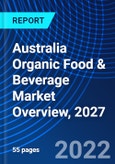This report comes with 10% free customization, enabling you to add data that meets your specific business needs.
1h Free Analyst TimeSpeak directly to the analyst to clarify any post sales queries you may have.
According to the report, Australia Organic Food & Beverages Market Overview, 2027, the market is projected to grow at a prominent compound annual growth rate during the forecast period. The surge in demand for clean-label food and beverage products is expected to be a significant driver for the growth of the organic food and beverage industry. Consumers have become more conscious regarding the food or beverages they consume. They want to gain information regarding the ingredients of the food and beverages, their source, and the certifications of government authorities to ensure that every product is organic and sustainable. The rise in health-consciousness among consumers exponentially increases the demand for sustainable food and beverages. The organic food and organic beverages market in Australia is projected to witness higher market growth due to government regulations supporting organic food and beverages, changing consumer perception towards organic food, and widening distribution channels. The increasing research and development activities for new products are providing ample opportunities for the organic food and organic beverages markets to grow in the coming years.
Generally, there has been a surge in demand for natural products in the Australia market due to the health benefits associated with their consumption. Consumers are attracted to healthy food products, especially natural ones. The absence of artificial ingredients in the production of organic drinks has given it leverage over other products in the same category in the market. This attribute will facilitate the growth of the organic drinks market during the forecast period. Furthermore, rising disposable income in developing countries is expected to fuel the industry's growth in the near future. Companies in the organic food market are focusing on the introduction of new product categories and varieties. Organic food manufacturers are coming up with new and innovative organic food products in the form of ready-to-eat snacks, cookies, organic tea, pulses, spices, edible flowers, frozen waffles, medical plants, herbs, and organic juices.
According to the report, the organic food market can be categorized as organic fruits and vegetables, organic frozen and processed foods, organic dairy products, and organic meat, fish, and poultry products. The organic fruits and vegetables category leads among the types of organic food markets, and the organic dairy products category is expected to grow at the highest rate in the coming years due to advancements in technologies, which help in extending the shelf life of the products. On the basis of products, the organic beverage market can be categorized as organic coffee and tea, organic non-dairy beverages, and organic beer and wine. In the coming years, organic beer and wine are expected to grow at the fastest rate of any type of organic beverage market. The organic food and beverage market can also be categorized on the basis of distribution channels as convenience stores, hypermarkets and supermarkets, online retailers, and food specialists. Based on sales channel types, the modern retail segment dominates the market in 2021 and is anticipated to continue growing during the forecast period.
COVID-19 Impacts:
The outbreak of the novel corona-virus amongst the developed, developing, and underdeveloped nations across the globe possesses the ability to impact the demand and supply chain of the market and, further, impact the maintained market equilibrium during the forecast period. Also, with the alarming rate at which the infection and pandemic are spreading, customers are recognizing this as an excellent opportunity to self-reflect and opt for the necessary changes in terms of leading a healthier lifestyle and consuming more products that are organic and make use of the natural ingredients and elements. However, the rising demand is unable to keep pace with the disruptions that are currently prevalent in the supply chain mechanism of organic food and beverage market services and products, but the scenario is anticipated to change based on growing demand for organic food and beverages across the Australia.Considered in the report
- Geography: Australia
- Historical year: 2016
- Base year: 2021
- Estimated year: 2022
- Forecasted year: 2027
Aspects Covered In the Report
- Market Size By Value for the time period (2016-2027F)
- Market Share by Type (Food & Beverage)
- Market Share by Food (Fruits & Vegetables, Meat, Fish & Poultry, Dairy Products, Frozen & processed Food)
- Market Share by Beverage (Non-Dairy, Coffee & Tea, Beer & Wine)
- Market Share by Sales Channel (Convenience Store, Modern Retail, Online Retail)
- Market Share by Country








